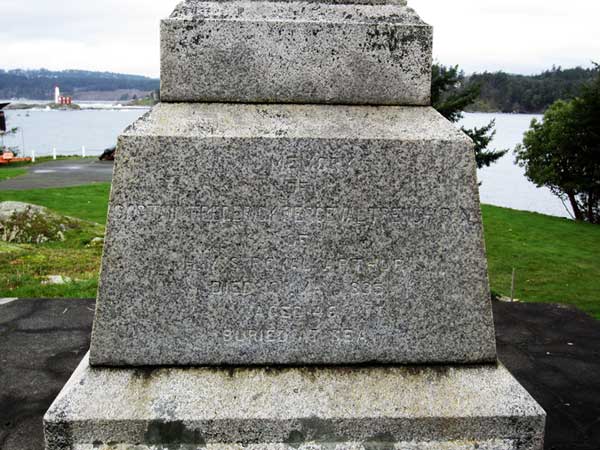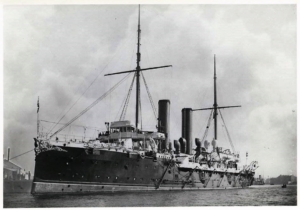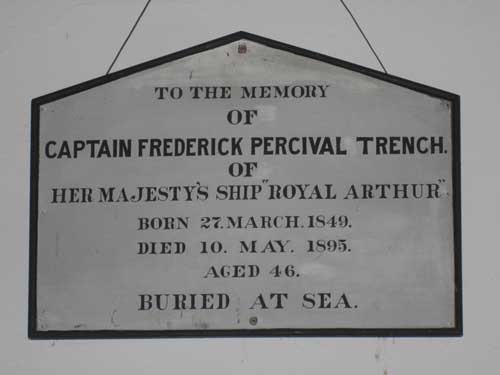Monument to
On a rocky knoll above Duntze Head in the Dockyard at Esquimalt stands an obscure obelisk monument near the flag staff and anchor.
This monument is a tribute to Captain Frederick Percival Trench of the Royal Navy. He was the Captain of HMS Royal Arthur, the flagship of the Pacific Station in the late 1890s; while off the coast of Mexico in May of 1895 he died suddenly and was buried at sea.
This story is told in an article published in the British Colonist on May 21, 1895, on page 6:
FROM CORINTO
H.M.S. “Royal Arthur” Back From the South – Captain Trench Dies at Sea
The Flagship Meets the “Hyacinth” With Disabled Propeller and Tows Her In
“The flagship Royal Arthur returned early Sunday afternoon from Corinto, where in company with the Satellite and Wild Swan she enforced Great Britain’s demand for $75,000 indemnity for the insolent treatment by Nicaragua of the British deputy consul and other citizens. This little episode was of course a welcome change for the Jack tars from the usual monotonous cruise, but after all there was not a great deal of excitement, with the exception of once or twice, when it seemed as if an armed collision might take place with the troops of the little republic. The Royal Arthur has been away from here since November 3, when she sailed for Acapulco; after a stay there of six weeks she cruised along the coast, touching at Callao, Coquimbo and Valparaiso, and also at Juan Fernandez Island. Finally, early in April, she lay at Panama waiting for the settlement of the Nicaraguan difficulty. As President Zelaya would not come to terms, the ships were ordered to Corinto as an additional argument in Britain’s favor. On April 22 the Royal Arthur, Satellite and Wild Swan, the last a screw sloop of 1,130 tons, commissioned at Davenport December 6, and despatched for the Pacific station, sailed into Corinto harbor and took up their position in front of the town. Corinto is a small place, not much better than a village, but is the seaport for the capital, Managun, situated further inland. Corinto, as everyone who has followed the course of events there knows, is on an island and is connected with the mainland by a fine bridge. There were 100 soldiers in Corinto when the fleet appeared, but they speedily took to the woods as the four or five seven-pounder guns they possessed were not very formidable weapons to oppose to the big guns of the warships.
“On the next day Commander Stokes went ashore and presented his despatches, the President being given to understand that the ships were there strictly on business, and urgent business at that.
On the 25th, when the Nicaraguans became convinced that they would have to pay up or allow the British to take possession of Corinto, they secretly as they imagined, dismounted a seven-pounder that was in position near the lighthouse, and placing it in their revenue cutter covered it over with gravel so as to hide it. The same day, Senor G. Bravo, a high official of the government, came off to the Admiral and tried unsuccessfully to get an extension of time.
“On April 27, under cover of the guns of the fleet, a force of 300 men were landed and occupied the town; the Union Jack was hoisted, and Captain Trench of the Royal Arthur was made governor. Then only 30 men were left to guard the town, though a good lookout was kept on the bridge approaches and the structure itself covered by the guns of the Satellite. The occupation was conducted so satisfactorily that the signal came from the flagship: “The Admiral is much pleased at the very satisfactory manner in which the occupation of the town was conducted this morning; the punctuality, steadiness and general appearance of the men reflected great credit on all concerned.”
“The Nicaraguan forces to the number of 2,000 were posted behind a gravel ridge on the mainland, and it was for a time thought that they would make an attack. On April 30, as an extra precaution, the guards were doubled, and the metals of the railway gun cotton was placed in mines to give a decidedly warm reception should the Nicaraguans attempt to cross the bridge. Three officers of the fleet in plain clothes ventured too near the enemy’s line, and before they could retreat an armoured train passed them on the railway, stopped and a body of soldiers jumped off and surrounded the officers, who however were released through the good offices of the interpreter. The men from the fleet got along very well with the inhabitants of Corinto, and had strict orders to treat everyone kindly. It was found, however, that by some hidden influence, the storekeepers were prevailed upon to refuse to sell goods to the British. This resulted in the arrest of a man named Casamira, formerly mayor of the town, and a man of great influence. He had gone about intimidating the storekeepers by saying he would have them executed when the British left, if any provisions were sold to the invaders. No trouble of this kind was experienced afterwards.
“After the settlement of the trouble the Satellite was sent to sea on May 4, the occupation of the town terminating that day and the railway and telegraph lines having been repaired. The next day the Royal Arthur recognized the Nicaraguan flag by firing 21 guns, and she and the Wild Swan started north for Esquimalt. The Wild Swan was towed to sea and is coming under sail as she has no coal; the Satellite is under sail for the same reason. The Royal Arthur, however, carries a large amount of fuel and had plenty to bring her home. The others will coal at Acapulco.
“A very regrettable occurrence was the death of Captain Trench, of the Royal Arthur, on May 10, when off the Mexican coast. He died of gastritis after an illness of 48 hours, and as it was in the tropics he was buried at sea with naval honors the same evening, in Lat. 19 d, 41 m N., Long. 106 d, 3 m W., off Cape Corrientes. Frederick Percival Trench was born March 27, 1849, and was therefore 46 years of age. Among his services he was 1st Lieutenant of the Turquoise during the military and naval operations in the Eastern Sudan at Suakim 1884 – 5; he received the Egyptian Medal and the Khedive’s bronze star. He took part in the Burmese conquest in 1885 – 6, was present at the fighting at Minhia, and at the capture of Mandalay. In command of the launch Kathleen he assisted in the successful cutting out of a Burmese war vessel from under the guns of the forts at Minhia. For this he was promoted and mentioned in naval and military dispatches. For the Burma campaign he received the medal and clasp.

The monument to Captain Fredrick Percival Trench RN was erected by the Admiral and Officers of HMS Royal Arthur as a token of their regard for him following his death.
“The vacancy caused by Capt. Trench’s death has been temporarily filled by Commander Stokes, acting captain; Senior Lieut. W. Nicholson being made acting commander, and Lieut. Hornby Senior Lieutenant. The Royal Arthur touched one place on the way up, at Monterey, on May 16. In tow the Royal Arthur brought H.M.S. Hyacinth, which after a cruise among the Pacific Islands put into Valparaiso on March 10 with her propeller injured. Not having a mechanical diver this could not be repaired, and the Royal Arthur meeting the Hyacinth at Valparaiso towed her out to sea and sent her north under sail, consequently the Hyacinth has been 57 days making the trip. The Royal Arthur sighted her yesterday morning outside Cape Flattery and took her in tow.”
The monument to Captain Trench is inscribed on two sides:
IN MEMORY OF
CAPTAIN FREDERICK PERCIVAL TRENCH RN
OF HMS ROYAL ARTHUR
DIED MAY 10, 1895
AGED 46
BURIED AT SEA
ERECTED BY ADMIRAL AND OFFICERS OF ROYAL ARTHUR AS TOKEN OF SINCERE REGARD
1895
This monument is well intact, but it would enhance it to have the inscribing blackened for clarity for those curious of heart about CFB Esquimalt’s naval historica.
There also resides on the wall in the Chapel at the Veteran’s Cemetery, a plaque dedicated to the memory of Captain Frederick Percival Trench; Buried at Sea.



 CFB Esquimalt Naval and Military Museum
CFB Esquimalt Naval and Military Museum CFB Esquimalt Naval and Military Museum
CFB Esquimalt Naval and Military Museum